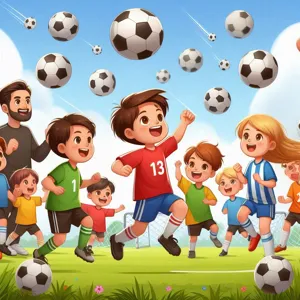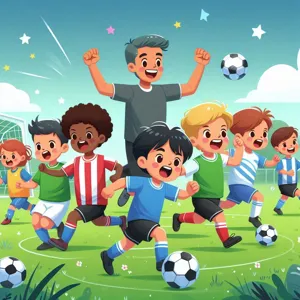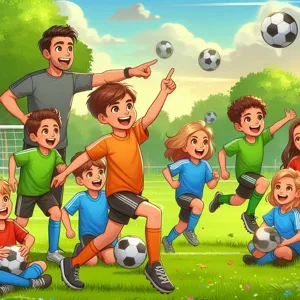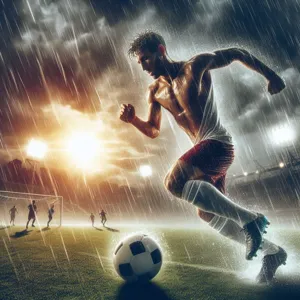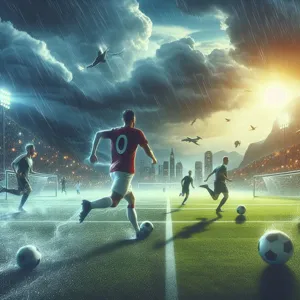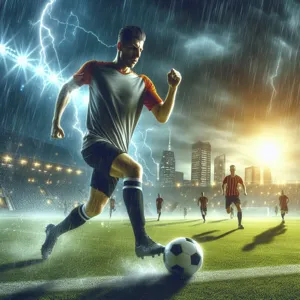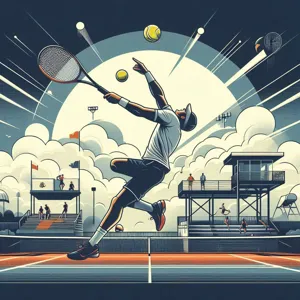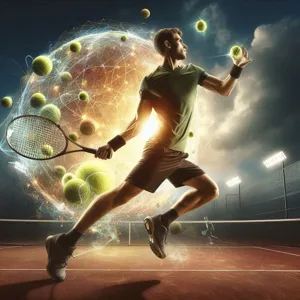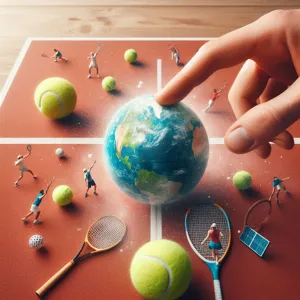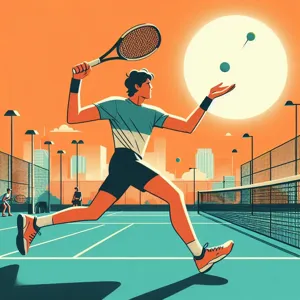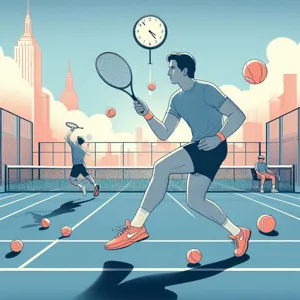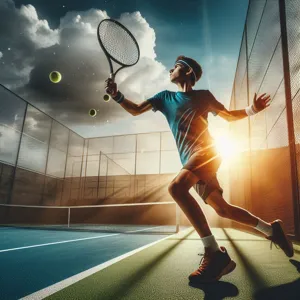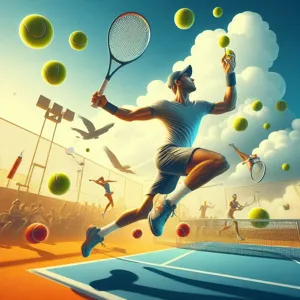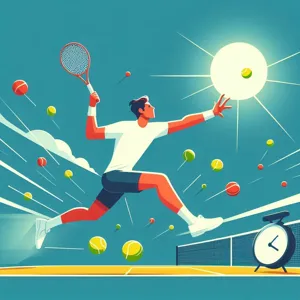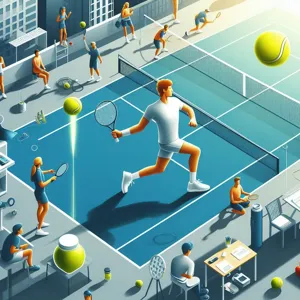Golf is a game of precision, strategy, and a dash of artistry, where every swing can tell a story of triumph or challenge.
For beginners stepping onto the fairway, mastering the fundamentals is just the start; understanding how to manipulate the ball’s flight path adds an exciting layer to your game. Enter the concepts of draws and fades—two essential shot shapes that can transform your play and elevate your performance. Whether you’re looking to navigate around pesky trees, tackle dogleg holes, or simply gain more control over your shots, learning the art of hitting draws and fades is key. In this comprehensive guide, we’ll break down the techniques, grips, and mental approaches needed to master these crucial shots. Get ready to unlock your potential and take your golf game to new heights as we delve into the world of curves on the course!
1. Understanding the Basics: What are Draws and Fades?
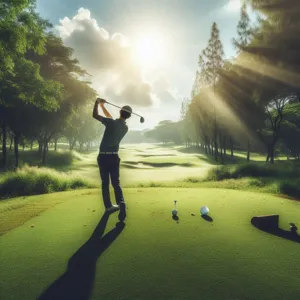
Before diving into the intricacies of hitting draws and fades, it’s essential to grasp the fundamental concepts behind these two shot shapes. At their core, a draw and a fade represent the intentional curvature of the golf ball during its flight, and understanding these concepts can significantly enhance your game.
A **draw** is a shot that curves gently from right to left for a right-handed golfer (and left to right for a left-handed golfer). This controlled hook not only provides extra distance due to the natural movement of the ball but also allows for more favorable angles when approaching the green. The draw typically occurs when the clubface is slightly closed relative to the swing path at impact, creating a spin that directs the ball to the left.
On the other hand, a **fade** is the opposite shot shape, curving from left to right for a right-handed golfer (or right to left for a left-handed golfer). This shot offers a high trajectory and often lands softly on the green, making it ideal for approach shots. A fade is achieved when the clubface is slightly open to the swing path at impact, imparting a spin that sends the ball to the right.
Understanding these two shot shapes is crucial for any golfer looking to navigate the course with confidence. Whether you’re facing a dogleg left that begs for a draw or an approach shot that requires a gentle fade around a tree, knowing how to manipulate the ball’s flight path will expand your arsenal and elevate your performance on the course. With practice and the right techniques, incorporating draws and fades into your game can open up new strategies and opportunities, allowing you to master the curve and tackle any challenge that comes your way.
2. The Science Behind Ball Curvature
Understanding the science behind ball curvature is key to mastering the draw and fade in golf. At its core, the way a golf ball curves in the air is influenced by three primary factors: the clubface angle at impact, the swing path, and the ball’s spin.
When you strike the ball, the angle of the clubface—whether it’s open, closed, or square—determines the initial direction the ball will travel. For a draw, the clubface should be slightly closed relative to the swing path, encouraging the ball to start right of the target (for right-handed golfers) and then curve back to the left. Conversely, achieving a fade requires the clubface to be slightly open at impact, allowing the ball to start left and then curve to the right.
The swing path is equally important; it refers to the direction in which the clubhead is moving at the moment of impact. A swing path that is inside-out will promote a draw, while an outside-in path will help produce a fade. The relationship between the clubface angle and swing path creates the unique spin on the ball, leading to its characteristic curve.
Moreover, the dimples on a golf ball play a crucial role in how it travels through the air. These tiny indentations create turbulence, allowing the ball to maintain lift and stability. The amount of spin generated during the swing interacts with these dimples, further influencing how sharply the ball curves.
By grasping these scientific principles, beginners can start experimenting with their techniques to intentionally achieve the desired ball flight. Whether you aim to shape your shots around obstacles or control your distance, understanding the mechanics of ball curvature will significantly enhance your overall game. As you practice and familiarize yourself with these concepts, you’ll gain the confidence to hit draws and fades with precision, ultimately mastering the art of shot shaping in golf.
3. Key Terminology Every Golfer Should Know

When embarking on your journey to mastering draws and fades in golf, familiarizing yourself with key terminology is essential. Understanding the lingo not only enhances your communication with fellow golfers but also deepens your comprehension of the game itself. Here’s a breakdown of the crucial terms every golfer should know:
1. **Draw**: A draw is a shot that curves gently from right to left (for a right-handed golfer) or left to right (for a left-handed golfer). This type of shot is often sought after for its ability to add distance, as it can maximize roll upon landing.
2. **Fade**: The opposite of a draw, a fade curves from left to right (for right-handed golfers) or right to left (for left-handed golfers). This shot is particularly useful for navigating around obstacles or positioning the ball closer to the pin on a right-to-left dogleg.
3. **Impact Position**: This refers to the position of your body and club at the moment the clubface strikes the ball. A solid impact position is crucial for achieving the desired shot shape, whether you’re aiming for a draw or a fade.
4. **Swing Path**: The path your club travels during the swing is vital in determining the direction and shape of your shot. A club that approaches the ball from the inside (towards your body) typically promotes a draw, while an outside-in path generally produces a fade.
5. **Clubface Angle**: The angle of the clubface at impact relative to the target line plays a significant role in shot shape. A closed clubface (pointing left of the target) can help produce a draw, while an open clubface (pointing right of the target) can create a fade.
6. **Ball Position**: Where you place the ball in your stance can influence the way it will react off the clubface. For draws, positioning the ball slightly back in your stance can encourage a more inside-out swing path, while for fades, placing it forward helps facilitate an outside-in path.
7. **Release**: This term describes the point in your swing where your hands and forearms rotate through impact. A proper release can significantly influence the shot shape, with a more pronounced release helping to create a draw and a restrained release often leading to a fade.
By understanding these key terms, beginners can demystify the complex mechanics of hitting draws and fades, paving the way for more informed practice sessions and improved performance on the course. Mastery of terminology not only builds confidence but also fosters a deeper connection to the game, making your golfing journey all the more enjoyable.
4. Grip It Right: How Your Grip Affects Shot Shape
When it comes to shaping your shots in golf, the grip is your first point of contact with the club and plays a pivotal role in determining the trajectory and direction of your ball. Understanding how to grip the club correctly can transform not just your performance but also your confidence on the course.
A proper grip begins with the fundamentals: how you hold the club can either promote a draw—a shot that curves gently from right to left (for right-handed golfers)—or a fade, which arcs from left to right. For a draw, you’ll want to position your hands slightly more to the right on the grip, allowing for a closed clubface at impact. This closed position encourages that desirable right-to-left movement as the ball flies through the air.
Conversely, if you’re aiming to achieve a fade, shift your grip to the left, which opens the clubface at impact. This adjustment invites that left-to-right trajectory, giving you that delicate slice through the air.
Moreover, consider the pressure of your grip. A relaxed grip can provide better feel and control, while a grip that’s too tight can lead to tension, affecting your swing and the resulting shot shape. Striking the right balance between firmness and relaxation is essential for executing both draws and fades effectively.
As you practice, pay close attention to how small adjustments in your grip can yield significant changes in your shot shape. The next time you’re at the driving range, experiment with different grips and notice how they influence your ball’s flight. By mastering the connection between your grip and shot shape, you’ll gain a valuable tool that can elevate your game and help you navigate the challenges of the golf course with greater precision and flair.
5. Stance and Alignment: Setting Up for Success

In golf, the importance of stance and alignment cannot be overstated. These fundamental elements serve as the bedrock upon which every swing is built, and getting them right is crucial for mastering draws and fades. When you stand on the tee, take a moment to assess your body position and alignment relative to your target. This is not merely about where you point your feet; it’s about establishing a complete setup that allows for the desired ball flight.
To execute a draw, start by positioning your feet slightly closer together than shoulder-width apart. This stable base will help facilitate a powerful and controlled swing. Aim your body alignment—a line formed by your feet, hips, and shoulders—slightly right of your target. This subtle adjustment encourages an in-to-out swing path, crucial for imparting the right spin on the ball. As you set up, ensure your weight is distributed evenly across your feet, allowing for a smooth transition during your backswing.
Conversely, if you’re looking to hit a fade, your stance will require a different approach. Begin by widening your stance for better balance, and then align your body slightly left of the target. This encourages an out-to-in swing path that promotes the left-to-right movement of the ball. Keep your shoulders square to your feet, and focus on a relaxed grip to allow for a natural release during your swing.
Regardless of whether you’re aiming for a draw or a fade, maintaining a consistent stance and alignment will significantly improve your accuracy and control. Take the time to practice these setups on the range, and soon you’ll find that the ball begins to fly with the trajectory you desire. Remember: a solid stance and proper alignment not only set you up for success but also build the confidence needed to address the ball with purpose—one of the keys to becoming a proficient golfer.
6. The Role of Swing Path in Creating Draws and Fades
The swing path plays a crucial role in shaping your shots, particularly when it comes to executing draws and fades. Understanding how your club moves through the impact zone can dramatically affect the direction and curvature of your ball flight.
Imagine your swing path as a highway that your club follows; where you direct that highway will determine where the ball goes. A draw, characterized by a gentle right-to-left curve for right-handed golfers, is typically achieved with an inside-to-out swing path. This means that as you take the club back, it moves slightly inside the target line, and then as you swing through, it moves outward, allowing the ball to start right and curve back toward the target. To help visualize this, picture a gentle arc that begins behind you and sweeps toward your target.
On the flip side, hitting a fade involves an outside-to-in swing path. For a right-handed golfer, this means your club starts outside of the target line on the backswing and moves across the ball on the downswing, resulting in a left-to-right ball flight. This path creates the necessary side spin that causes the ball to drift away from the target, often landing softly on the green with a controlled bounce.
To master these curves, practice is key. Use alignment sticks or cones on the range to help visualize and reinforce the desired swing path. Experimenting with ball position and tee height can also influence how effectively you can achieve these shots. Remember, the goal isn’t just to hit draws and fades but to develop a consistent swing path that allows you to control your shots with precision. As you become more aware of your swing path, you’ll find that executing these curves becomes second nature, opening up new possibilities on the course and enhancing your overall game.
7. Adjusting Your Clubface Angle

Adjusting your clubface angle is a crucial step in mastering the art of hitting draws and fades in golf. The clubface angle at the moment of impact significantly influences the trajectory and spin of the ball, ultimately determining its flight path. Understanding how to manipulate this angle can empower you to achieve the desired shot shape with confidence.
To hit a draw, you’ll want to close the clubface slightly at address. This means positioning the clubface so that it points slightly left of your target line (for right-handed golfers). By doing so, when you swing, the clubface will be closed relative to the swing path, allowing the ball to start right and then curve back to the left. It’s essential to practice this adjustment, as a too-closed face can lead to hooks, while a perfectly angled face creates that smooth, inviting draw.
Conversely, if you aim to hit a fade, you’ll need to open the clubface slightly at address, pointing it just to the right of your target line. This subtle adjustment allows the ball to start left and curve gently back to the right. The key here is to ensure that your swing path remains outside-in; if your swing path is too far left, even a slightly open face can lead to a slice.
In both cases, the grip also plays a vital role. For draws, a neutral to strong grip can help maintain control over the clubface, while for fades, a neutral to weak grip might provide the right feel to keep the face open through impact.
Practicing these adjustments on the range can be incredibly beneficial. Set up with alignment sticks to visualize your target line and clubface angle, and take slow, deliberate swings to get comfortable with the changes. With time and practice, adjusting your clubface angle will become second nature, allowing you to master those coveted draws and fades and elevate your game to new heights.
8. Drills to Practice Hitting Draws and Fades
When it comes to mastering the art of hitting draws and fades, practice is essential. Incorporating targeted drills into your routine can significantly enhance your ability to shape shots with precision. Here are a few effective drills designed to help beginners get comfortable with both draws and fades.
**Draw Drill: The Inside-Out Path**
To cultivate a reliable draw, start with the Inside-Out drill. Position two alignment sticks or clubs on the ground, creating a gate that your ball must travel through. Place one stick slightly to the right of your target (for a right-handed golfer) and another parallel to your target line, about a foot behind the ball. This setup encourages an inside-out swing path. As you practice, focus on swinging from inside the stick on your backswing, then through the gate toward your target. This motion will help you naturally close the clubface slightly at impact, promoting that coveted draw.
**Fade Drill: The Outside-In Path**
For those looking to master a fade, the Outside-In drill is key. Set up a similar alignment with your sticks, but this time, angle the stick to the left of your target. As you prepare to swing, concentrate on taking the club back on an outside path and then cutting across the ball slightly during your downswing. This drill will help you open the clubface at impact, creating the spin needed for a fade. Focus on maintaining a smooth tempo to ensure you don’t overexert yourself in an effort to cut across the ball.
**The Tee Drill**
Another effective way to practice these techniques is by using tees. Place two tees in the ground, one for your ball and another just in front of it, angled toward your target. When attempting a draw, aim to clip the first tee cleanly while keeping your swing path inside. For a fade, aim to strike the first tee while ensuring your swing path is slightly outside. This method reinforces your swing mechanics while providing instant feedback on your accuracy.
**Visualizing the Shot**
Before each swing, take a moment to visualize the shot you want to execute. Picture the ball’s flight path in your mind, whether it’s a gentle draw curling towards the target or a fade that starts right and gently drifts back left. This mental rehearsal not only boosts your confidence but also aids in solidifying the necessary swing changes.
By integrating these drills into your practice sessions, you’ll develop the muscle memory required to hit draws and fades with consistency. Remember, patience is key—progress may take time, but with dedicated practice, you’ll find yourself mastering the curve in no time!
9. Common Mistakes to Avoid When Trying to Curve the Ball
When it comes to curving the ball in golf, even the smallest misstep can lead to frustrating mishits or unintended shot shapes. As a beginner, it’s crucial to be aware of the common mistakes that can hinder your progress and prevent you from mastering draws and fades. Here are some pitfalls to avoid:
**1. Overthinking the Mechanics:** One of the biggest traps for novice golfers is getting too bogged down in the technical details. While understanding the mechanics of a draw or fade is important, overanalyzing each swing can lead to tension and inconsistency. Instead, focus on the fundamentals—grip, stance, and alignment—while allowing your body to develop a natural rhythm.
**2. Neglecting Setup:** Your setup plays a critical role in the ball’s flight path. Many beginners fail to align their body properly for the desired shot shape. For a draw, ensure that your feet, hips, and shoulders are aimed slightly right of the target, while the clubface points at the target. Conversely, for a fade, aim left while keeping the clubface directed toward the target line. Neglecting this alignment can result in a straight shot or an unintended curve.
**3. Gripping Too Tightly:** A common mistake that can affect your swing and shot shape is gripping the club too tightly. A tense grip can lead to a rigid swing and a loss of feel, making it difficult to manipulate the ball’s curve. Instead, maintain a relaxed grip pressure to allow for better control and a smoother swing.
**4. Rushing the Swing:** In the quest for the perfect draw or fade, beginners often rush their swings in an effort to generate power. However, a hurried swing can lead to poor timing and inconsistent contact. Focus on a smooth, controlled tempo to ensure that you’re making solid contact with the ball, which is essential for achieving the desired curve.
**5. Ignoring the Follow-Through:** The follow-through is just as crucial as the backswing and impact when it comes to curving the ball. Many beginners neglect their follow-through, which can affect the spin and trajectory of the shot. For a draw, ensure that your hands finish high and your body rotates toward the target. For a fade, let your follow-through naturally arc to the left, helping to create that desired left-to-right ball flight.
By being mindful of these common mistakes, you’ll be better equipped to make the necessary adjustments to your technique. With practice and patience, you’ll find yourself confidently curving the ball, adding versatility to your game and elevating your performance on the course.
10. Equipment Considerations: Clubs and Balls for Optimal Performance
When it comes to mastering the art of hitting draws and fades, the right equipment can make a significant difference in your performance. Every golfer is unique, and understanding how your clubs and balls can enhance your skills is crucial for achieving optimal results on the course.
First, let’s talk about the clubs. The loft, lie angle, and shaft flex of your clubs all play a fundamental role in shaping your shots. For example, clubs with a lower loft can help you achieve a more penetrating flight, making it easier to hit a draw, while higher-lofted clubs can promote a fade by adding backspin. Additionally, the lie angle affects how the club interacts with the ground at impact; a proper fit can help you make cleaner contact, which is essential for executing controlled shots.
Shaft flex is another critical factor. If you have a slower swing speed, a more flexible shaft can help you generate additional clubhead speed, which may aid in creating the desired shot shape. Conversely, if you have a faster swing speed, a stiffer shaft can provide the control needed for more consistent fades. Getting fitted for your clubs by a professional can give you invaluable insights into which specifications will work best for your swing style.
Now, let’s shift our focus to golf balls. The cover material, compression, and dimple design of a golf ball can influence its performance in the air. For instance, if you want to hit a draw, consider a ball that offers softer compression, as it tends to produce less spin and can help achieve a more controlled flight path. On the other hand, for a fade, a firmer ball may give you the spin needed to cut through the air with precision.
Lastly, don’t overlook the importance of consistency in your equipment. Using the same clubs and balls regularly allows you to develop a feel for how they perform, making it easier to replicate your draws and fades. Experimenting with different brands and models can also lead to surprising discoveries about what works best for your game.
In summary, investing time and thought into your equipment can profoundly impact your ability to hit draws and fades with confidence. By selecting the right clubs and balls tailored to your swing characteristics, you’ll set yourself up for success and enjoy a more rewarding golf experience.
11. The Mental Game: Visualizing Your Shots
In the realm of golf, the mental game often holds as much weight as physical skill. Visualization is a powerful tool that can elevate your performance on the course and help you master the art of hitting draws and fades. Before you even step up to the tee, take a moment to close your eyes and envision the shot you want to execute. Picture the trajectory of the ball, the curve it will take, and where it will land. This mental rehearsal not only boosts your confidence but also prepares your brain and body to execute the shot more effectively.
Start by imagining the hole layout and how your desired shot fits into it. Visualize the draw wrapping around a tree or the fade that gently drifts away from the water hazard. Consider the conditions—how does the wind influence your shot? As you build this mental image, engage all your senses: hear the sound of the club striking the ball, feel the grip in your hands, and even smell the fresh-cut grass. The more vivid and detailed your visualization, the more likely you are to create the shot you envision.
Incorporating visualization into your pre-shot routine can also help manage nerves and focus your mind. When you step up to the ball, take a deep breath, clear your thoughts, and recall the positive images you created. This practice not only calms your mind but also reinforces the mechanics needed to achieve that draw or fade. Remember, golf is as much about the mental aspect as it is about physical technique; by mastering the mental game of visualization, you can unlock your potential and take your shots to new heights.
###
12. Course Management: When to Use Draws and Fades
Course management is a crucial element of strategic play in golf, and understanding when to utilize draws and fades can significantly enhance your game. These shot shapes are not just stylistic choices; they are powerful tools that can help you navigate the complexities of the course and maximize your scoring potential.
When you’re faced with a left-to-right dogleg, for instance, a well-executed draw can be your best friend. By shaping the ball from right to left, you can create a more advantageous angle into the green, allowing for a clearer shot at the hole. Conversely, when encountering a right-to-left dogleg, opting for a fade can help you stay in play while avoiding hazards that lurk on the left side of the fairway.
It’s essential to recognize the layout of the course and how wind conditions can impact your shots. A draw can penetrate the wind, making it a favorable choice on blustery days, while a fade can help you control your distance and land softly on greens. Additionally, consider the pin placement—if the hole is tucked on the left side of the green and protected by a bunker, a fade will provide a safer approach, allowing for more room for error.
Effective course management is all about making smart decisions at every turn. By knowing when to use draws and fades, you can navigate the course with confidence, setting yourself up for success on the greens. Take the time to assess each hole’s unique challenges, and don’t hesitate to adjust your strategy based on your strengths and the conditions at hand. Mastering this skill will not only improve your game but will also deepen your appreciation for the nuances of golf.
13. Analyzing Professional Techniques: Learning from the Pros
When it comes to mastering the art of hitting draws and fades, there’s no better resource than watching the professionals in action. Analyzing the techniques of seasoned golfers not only provides insight into the mechanics of the swing but also unveils the subtle nuances that can make a significant difference in ball flight.
Start by tuning into televised tournaments or online match replays, focusing on the players renowned for their shot shaping abilities. Pay close attention to their stance, grip, and swing path. Notice how they position their body and clubface at address—this initial setup is crucial for controlling the draw or fade. For instance, a closed clubface at impact, along with an inside-out swing path, is often employed to generate that desirable draw, while an open clubface paired with an outside-in path promotes a fade.
Beyond the technical aspects, observe how pros manage their mental approach. They visualize the shot before executing it, often imagining the curve of the ball in their minds. This visualization is key; it primes their body to perform the necessary adjustments instinctively. As you practice, adopt this mental strategy—picture the trajectory and spin of your shot, and trust in your swing mechanics.
Moreover, don’t hesitate to study their practice routines. Many professional golfers dedicate time to specific drills that enhance their ability to shape shots accurately. Whether it’s hitting into a net with a specific target in mind or using alignment sticks to ensure proper swing path, these drills can be adapted to your own practice sessions.
By delving into the techniques of the pros, you not only gain valuable insights into the mechanics of draws and fades but also cultivate a deeper understanding of the mental game. Incorporating these lessons into your training will undoubtedly accelerate your progress, bringing you one step closer to mastering the curve on the course.
14. Troubleshooting: What to Do When Shots Don’t Curve as Expected
Even the most seasoned golfers encounter moments of frustration when their shots fail to curve as intended. Whether you’re aiming for a gentle draw that turns gracefully to the left or a fade that slices subtly to the right, understanding the reasons behind unexpected shot trajectories can help you adjust and improve your game.
First, consider your grip. An incorrect grip can significantly impact the direction and spin of your ball. If your grip is too strong, it can lead to hooks instead of draws; conversely, a weak grip may cause your shots to fade more than anticipated. Take a moment to reassess how you’re holding the club; a neutral grip is often the key to allowing the natural curve to develop.
Next, focus on your stance and alignment. If your body is angled too far left or right of your target line, it can throw off your swing path and lead to unpredictable results. Ensure your feet, hips, and shoulders are aligned parallel to your target line and that you’re addressing the ball correctly. A slight adjustment in alignment can make a significant difference in how the ball behaves once it leaves the clubface.
Another critical element is your swing path. The angle and direction in which you swing the club will determine the ball’s initial trajectory and spin. If you find yourself consistently hitting straight shots instead of draws or fades, try to visualize the path of your swing. For a draw, focus on an in-to-out swing path; for a fade, an out-to-in path may be necessary. Practicing these variations can help solidify your muscle memory and make it easier to replicate the desired shot shape.
Lastly, don’t forget about the importance of clubface angle at impact. The clubface should be slightly closed for a draw and open for a fade. If the face is square at impact, your shots will likely fly straight. Use alignment sticks during practice to help you visualize and achieve the correct clubface position.
If you find that your shots are still not curving as expected, take a step back and simplify your approach. Sometimes, overthinking the mechanics can lead to tension and inconsistency. Focus on your smooth, natural swing and allow the curve to develop organically. With practice and patience, you’ll gain a better understanding of what works for you and soon be able to master those draws and fades with confidence. Remember, even the pros have off days—embrace the learning process and enjoy your time on the course!
15. Conclusion: Embracing the Learning Curve in Your Golf Game
As we wrap up this beginner’s guide to hitting draws and fades, it’s essential to recognize that mastering these techniques is an ongoing journey rather than a destination. Golf, like any skill-based activity, is about embracing the learning curve and understanding that every swing, every shot, and every round of play offers valuable lessons.
The beauty of golf lies in its complexity and the endless opportunities for improvement. Whether you’re stepping onto the course for the first time or have been playing for years, remember that it’s perfectly normal to experience ups and downs. The key is to approach your practice with patience and persistence. Celebrate your progress, no matter how small, and don’t shy away from seeking advice or guidance along the way.
As you experiment with draws and fades, allow yourself the freedom to make mistakes. These missteps are not failures; rather, they’re stepping stones toward developing a more versatile game. Each time you adjust your grip, stance, or swing path, you’re gaining insight into what works for you.
So, as you move forward, keep your mind open and your heart engaged. Embrace the challenge, enjoy the process, and remember: every great golfer started as a beginner. With dedication and a positive mindset, you’ll find yourself not only enhancing your skills but also deepening your appreciation for this remarkable game. Now, grab your clubs, head to the range, and let the journey unfold!
As we wrap up our exploration of mastering draws and fades in golf, we hope you feel empowered to take your game to the next level. Understanding the intricacies of ball flight and learning how to manipulate your shots can transform your approach on the course, giving you the confidence to tackle any situation. Remember, practice is essential—so don’t hesitate to spend time at the driving range experimenting with the techniques we’ve discussed. Whether you’re aiming for a graceful draw or a sharp fade, with patience and persistence, you’ll gradually see improvements in your performance. So grab your clubs, hit the greens, and enjoy the journey of becoming a more versatile golfer. Happy swinging!

